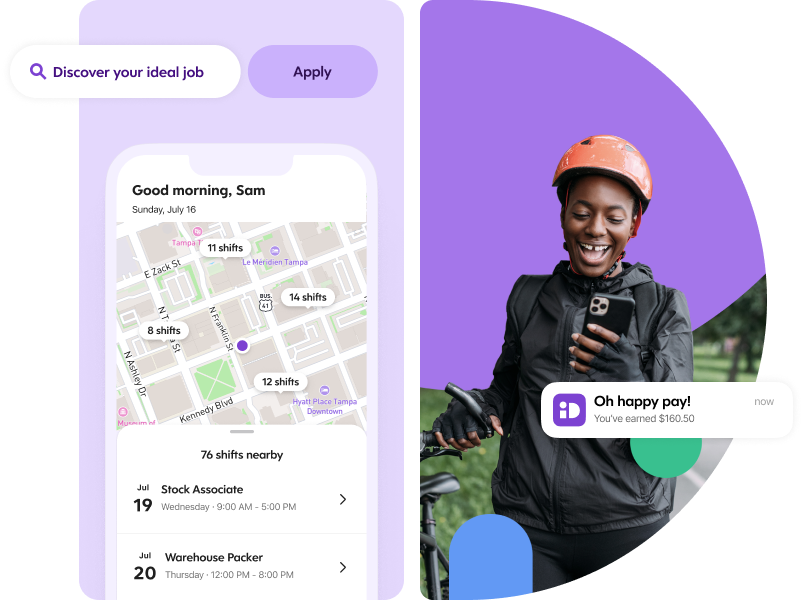The ideal way to work
Find flexible shifts near you and choose to get paid the same day.
Available on iOS and Android.
Get started
Flexible work, on demand
Ideal matches people with shifts. It’s that simple.
We make it easy for you to find flexible shift-based work and for organizations to scale their workforce with our on-demand marketplace.

Looking for work?
Choose when and where you work
- Create your own schedule
- Join a supportive community that invests in your success
- Apply once, unlock countless opportunities
- Get paid the same day you work with Dayforce Wallet
Looking for people?
Fast and reliable staffing
- Scale your workforce to meet demand
- Fill gaps in your schedule instantly with verified talent
- Tap into new and diversified talent pools
- Reduce overhead; we handle W-2 worker admin
Flexible work made easy
Download the app and get started in few easy steps.

Create your profile
Tell us about yourself then complete a background check and I-9. Once verified, you can access shifts that match your profile.

Find shifts
We’ll recommend shifts that match your profile, or you can find opportunities based on your preferences and build your own schedule.

Opt for same day pay with Dayforce Wallet
Once you’ve worked your shift, you have access to your net earnings on demand.
The ideal way of working
A simple way to build your own schedule, with a few extra perks.
Same day pay
Access your net earnings on demand, as you finish your shift.
Own your schedule
Choose your hours and locations, see the pay rate, and only accept the shifts you want to work.
One profile, many jobs
Set up your profile once, and we’ll show you all the shifts you can work across different industries.
Ideal advantages
We handle admin including payroll and taxes.
Join our community
Be part of a growing community of workers forging a flexible career path. Plus, you can learn new skills as you work.
World class support
We’re here for every step of your worker journey, whenever you need assistance.
Find your ideal shift
Explore new opportunities in your area, with shifts available across a variety of industries.
Be the life behind the party helping with set up, tear down, and crowd control.
Bring your foodie enthusiasm and guest service skills as you prepare and serve fans’ food.
Serve food and beverages to guests and provide a positive customer experience.
Gather and pack individual orders that delight customers.
Calling all cleanliness experts to provide cleaning and janitorial services.
Be the hero behind every delicious meal. Help maintain a clean and safe kitchen.
Handle grocery items with care as you pack groceries like a Tetris expert.
Be a customer service champion by answering questions with knowledge and care.
Put your passion to work providing compassionate care and assistance to residents.
Common questions

Get started today by downloading the Ideal app and completing your profile, which only takes a few minutes. The app will guide you through the onboarding process step by step to help you get working and earning money!
With Ideal, you choose when and where you work. Find work near you with the Explore tab on our app. Pick up shifts that fit into your schedule and lifestyle.
From warehouse associates to event staff, Ideal has work from across a variety of industries and roles. Explore the app to see what’s available in your area today.
When you work with us at Ideal, you are joining a community that is looking to change the way we work. We think people should have the power to choose their own schedules while still having access to the benefits of traditional work. Our dedicated Community team is here to ensure that we foster inclusion, encourage collaboration, and create a vibrant environment for all our workers. The Community team organizes a variety of events ranging from on-site lunches to off-site social gatherings at local restaurants, bowling alleys, and more.
Ideal uses Dayforce Wallet so you can access your net earnings pay, the same day you work without any fees. We also offer direct deposit.